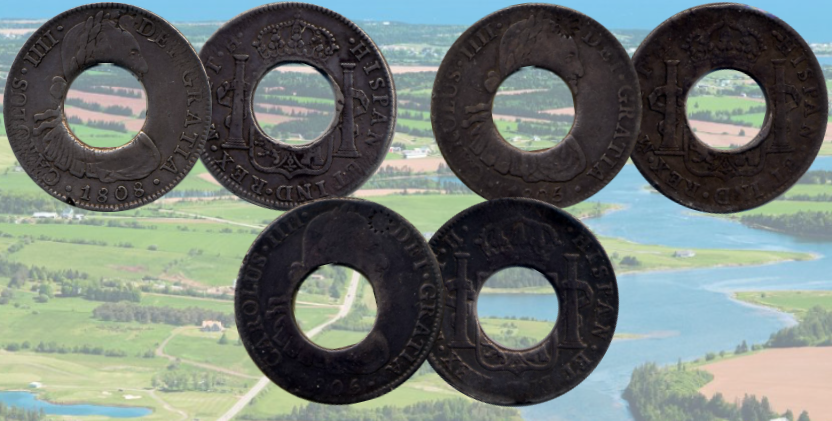By George Manz
Three rare pierced and counterstamped holey dollars from Prince Edward Island will be on display at the Regina Coin Club Spring 2020 Show and Sale on April 18-19.
In 1813, soon after the arrival of Lieutenant Governor Charles Douglas Smith to Prince Edward Island, which was then a British colony, Smith announced a new coinage would be introduced because of a shortage on the island.
And what a coinage it was.
Because most merchants on Prince Edward Island had to import their goods for sale from either Great Britain or nearby Halifax, N.S., the merchants hoarded any coinage that came their way. Because of this, it was difficult to make transactions with no money readily available.
Smith decided to import 1,000 Spanish-American eight-reales coins and pierce the centre of each, thereby producing two tokens: the centre or plug was worth one shilling while the ring – or holey dollar – was worth five shillings. Because the eight-reales coin was worth five shillings throughout the British Empire, the two new tokens were worth 20 per cent more on Prince Edward Island than in other jurisdictions.
Each holey dollar and plug were counterstamped with a mark of 10 triangles resembling a star.
Smith then issued a proclamation on Sept. 24, 1813. It reads in part: “It is also ordered that Spanish Dollars, limited to the amount of One Thousand, shall be cut at the Treasury, by having a circular piece taken out of the centre of each – the Dollars so cut, are to be issued from and received at the Treasury at the rate of Five Shillings Currency each, and the piece so taken out to be issued from and received at the Treasury at one shilling currency each.”
PEI HOLEY DOLLARS
Christopher Faulkner’s wonderful book The Holey Dollars and Dumps of Prince Edward Island was published by Spink in 2012.
Faulkner’s book describes in detail how and why they were produced and lists 79 holey dollars then known to exist. Eight years after publication, another four have turned up, making a grand total of 83 holey dollars.
The three holey dollars on display in Regina will include the “Hill Dollar,” the “Foster Dollar” and the “Norweb Dollar,” each named after former owners in their provenance.
The Hill Dollar was minted in Mexico City in 1808 during the reign of Charles IV of Spain. It is named after Leslie Hill, of British Columbia, a long-time coin collector, coin dealer and author.
The Foster Dollar was minted in Mexico City in 1805 during the reign of Charles IV of Spain. It is named after Joseph C. Foster, of Virginia, but other notable owners include Doug Robins, whose massive token collection sold at auction in 2018, and long-time collector and dealer Geoffrey Bell.
The last Holey Dollar on display is called the Norweb Dollar, named after R. Henry Norweb and Emery May Norweb, of Ohio. It was minted in Mexico City in 1805. The Norwebs were prominent U.S. collectors who amassed a massive number of coins and tokens during their lifetimes.
Similar pieces were produced in New South Wales Australia as well as in the Caribbean.
The three Prince Edward Island holey dollars will be on display at the Regina Coin Club Spring 2020 Show, which will be held at the Turvey Centre, just north of Regina, Sask.
George Manz is the president of the Regina Coin Club and a Fellow of the Royal Canadian Numismatic Association.

